 MISSION MISSION |
ORTPN is a public institution, which was created
by Presidential decree in June 1973.
The office is a parastatal with administrative
and financial autonomy, guided by 6 board members
and a chairman. The Board Secretary also serves
as the Director General of ORTPN and all board
members are appointed by Parliament. Its key mandates
are :
· National Parks Management and Conservation
· The promotion of Tourism and Cultural
Heritage
· The development and management of Sites
and Monuments.
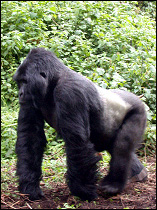
Park fees, Government subsidies and grants from
partners and donors finance the running of the
Office. ORTPN pursues its tasks in close collaboration
with its NGO partners and the private sector,
in matters of conservation and in promoting tourism.
Given the growing importance of tourism at both
National and International levels, the government
is currently in the process of restructuring ORTPN
in order to encourage a more focused and dynamic
approach to Tourism Promotion and Conservation
Management.
Akagera National Park
The magic of the African bush 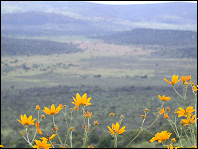
Akagera comes as an exciting surprise after the
steep cultivated hills and breezy climate that
characterize the test of the country. Set at a
relatively low altitude along the Tanzanian border,
this beautiful game reserve protects an archetypal
African savannah landscape of tangled acacia and
brachystegia bush, interspersed with patches of
open grassland and a dozen swamp-fringed lakes
that follow the meandering course of the Akagera
River.
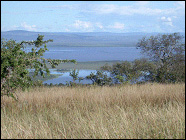
Akagera's stirring and varied scenery is complemented
by a superb range of big game. Herds of elephant
and buffalo are most likely to be encountered
when they emerge from the dense woodland to drink
at the lakes, while lucky visitors might stumble
across a lion, a leopard or a spotted hyena. Giraffe
and zebra are frequently seen in open woodland,
and more than a dozen types of antelope inhabit
the park, most commonly the handsome chestnut-coated
impala, but also the diminutive oribi and secretive
bushbuck, as well as the ungainly tsessebe and
the world's largest antelope, the magnificent
Cape eland.


To camp alongside Akagera's picturesque lakes
is a truly mystical introduction to the wonders
of the African bush. Pods of 50 hippopotami grunt
and splutter throughout the day, while outsized
crocodiles soak in the sun with their vast jaws
menacingly agape. Magically, the air is torn apart
by the unforgettable high duetting of a pair of
fish eagles, asserting their status as the uncontested
king and queen of Africa's waterways. Lining the
lakes are some of the continent's densest concentrations
of water birds - storks, egrets, ibises, plovers,
sandpipers, kingfishers and herons. The connecting
marshes are the haunt of localised papyrus specialists
such as the red, yellow and black papyrus gonolek,
the secretive blue-headed coucal, and the singularly
bizarre shoebill stork - the latter perhaps the
most sought-after of all African birds.
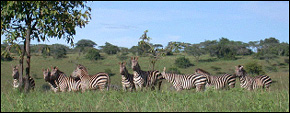
 PARC
NATIONAL DES VOLCANS PARC
NATIONAL DES VOLCANS |
Gorillas in the Mist
"In the heart of central Africa, so high
up that you shiver more than you sweat, are great,
old volcanoes towering up almost 15000 feet, and
nearly covered with rich, green rainforest - the
Virungas"
- Dr. Dian Fossey describing the intensely beautiful
mountain range on which she spent the last two
decades of her life studying Rwanda's endangered
mountain gorillas.
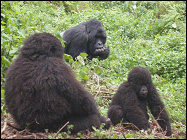
Protected within the Parc des Volcans, the lushly
forested slopes of the Virungas form an appropriately
dramatic natural setting for what is arguably
the most poignant and memorable wildlife experience
to be had in the wilds of Africa: gorilla tracking.
The exhilarating climb to the gorillas' habitat
of shady bamboo forest offers fantastic views
in all directions, before trekkers are immersed
in the mysterious intimacy of the rainforest,
alive with the calls of colourful birds and the
chattering of the rare golden monkey.
Nothing can prepare one for the impact of encountering
a fully-grown silverback gorilla: up to three
times as bulky as the average man, yet remarkably
peaceable and tolerant of human visitors. Nor
are these words to describe the thrill of recognition
attached to staring deep into the liquid brown
eyes of these gentle giants, which share some
97% of their genes with humans.
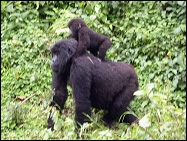
That mountain gorillas survive today is largely
thanks to Dian Fossey, who is buried at her research
center in the Virungas alongside the animals to
which she dedicated her life. Fossey became a
household name following the release of the biographical
film Gorillas in the Mist, set and shot on location
in the Parc National des Volcans. Critical and
public acclaim ensured that Gorillas in the Mist
also served to raise international awareness of
the plight of the mountain gorilla. A mere 300
of these gentle giants survive in the wild, half
of them resident in Rwanda, where four habituated
groups - ranging in size from 7 to 33 individuals
- can be visited by up to 32 tourists daily.
The main base for gorilla tracking, Ruhengeri,
is a small but bustling market town situated 15km
from the base of the Virungas. Boasting a wonderful
sub-montane setting, and an excellent range of
cheap to midrange hotels, Ruhengeri is an agreeable
place to spend the night before one goes gorilla
tracking, as well as being the obvious base from
which to explore the little-known but compellingly
beautiful Lakes Burera and Ruhondo. Alternatively,
visitors seeking a higher level of comfort could
base themselves in Gisenyi or Kigali, and - with
an early start - head to Ruhengeri as a day trip
from there.
 NYUNGWE
NATIONAL PARK NYUNGWE
NATIONAL PARK |
Primate and Bird Nirvana
Nyungwe National Park, extending for almost 1000km2
across the majestic hills of southeast Rwanda, is
the largest 'island' of montane forest remaining
in East or Central Africa: a rich and ancient centre
unparalleled biodiversity and natural wonders. Transected
by the surfaced road between Butare and Lake Kivu,
Nyungwe and its array of forest inhabitants are
also uniquely accessible to casual visitors.
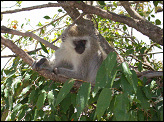 |
Approach Nyungwe along
the main road, and you will initially be struck
by the forest's glorious sense of expansiveness;
a lush verdant swathe across the mighty hills that
roll like gigantic green waves towards the distant
horizon. Paradoxically, when you follow the walking
trails within Nyungwe, it is the intimacy of the
rainforest that most impress: the closed canopy
overhead, the towering trees and delicate ferns
that line the steep gorges, the mysterious calling
and rustling of birds and monkeys hidden deep in
the greenery.
Recently accorded national park status, Nyungwe
is rightly celebrated for the rich variety of
its flora and fauna. At least 200 different types
of tree are found in the forest, along with hundreds
of different flowering plants, including wild
begonia, more than 100 species of orchid, and
sensational giant lobelias. Of the large mammals,
primates are the most visible, with 13-recorded
species representing 25% of the African primate
checklist. Of particular interest is the Angola
colobus - delightfully acrobatic arboreal monkeys
that move in troops of several hundred - and an
estimated 500 chimpanzee, often seen from the
forest trails during the rainy season. Other primates
likely to be encountered over the course of a
visit are L'Hoest's monkey, vervet monkey, olive
baboon, grey-cheeked mangabey, and red-tailed
monkey.
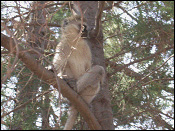
Home to more than 275 bird species, Nyungwe is
the most important birding site in Rwanda. Most
alluring to ornithologists are 24 Albertine Rift
endemics - birds whose range is restricted to
a handful of montane forests between southern
Uganda and northern Burundi - a list that includes
the spectacular Ruwenzori turaco, secretive red-chested
alethe, and several iridescent sunbirds. Equally
remarkable are the perpetually honking giant hornbills
that crash through the forest canopy, and the
stunning great blue turaco - an outlandishly blue,
red and green bird most often seen gliding from
one tree to the next in procession.
Far from being the sweaty tropical jungle one
might expect, Nyungwe lies at elevation of between
1600m and 2950m, and enjoys an agreeable cool
climate. An extensive network of well-maintained
forest trails lead to various waterfalls and viewing
points. A comfortably rustic rest house and perfectly
situated campsite lie alongside the main road,
and the reserve can be readily visited as a day
trip from smarter hotels in the towns of Butare
and Cyangugu. Nyungwe does, however, deserve more
time: anybody who wants to track chimps and see
several varieties of smaller primate will need
two days there - and dedicated birdwatchers might
never want to leave this magical forest!
 THE
LAKES THE
LAKES |
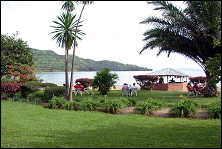
Lake Kivu is extraordinarily beautiful: a vast inland
sea enclosed by the steep, green terraced hills
that are so characteristic of rural Rwanda. Along
its shores lie three resort towns, Gisenyi, Kibuye
and Cyangugu, connected by a wild roller-coaster
road that tumbles through lush plantain fields and
relic patches of misty rainforest to offer sweeping
views over the shimmering lake.
Gisenyi, a short drive from Ruhgengeri and the Parc
des Volcans, is set on a sandy beach lined with
swaying palms and colonial-era hotels that positively
exude an atmosphere of tropical languor. At Kibuye,
tourist activities are centered around a modern
lakeshore guesthouse, which overlooks pine-covered
hills seemingly transplanted from the Alps. Different
again is Cyangugu, close to Nyungwe Forest, where
most subdued tourist development is compensated
for by perhaps by the most spectacular setting of
them all.
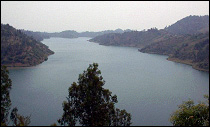
Lake Kivu is the largest of numerous lakeswhich
fill the valleys of Rwanda. Lakes Burera and Ruhondo,
close to the gorilla-tracking centre of Ruhengeri,
are often neglected gems: deep blue waters ringed
by steep hills and tall waterfalls, with the outlines
of the nearby Virunga Volcanoes providing a spectacular
backdrop, particular as seen from the comfortable
Foyer de Charité guesthouse on lake Ruhondo.
Further south, Lake Muhazi makes for a good day
trip from Kigali, with overnight camping available.
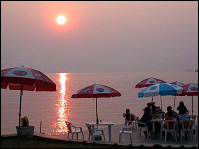
Gisenyi and Kibuye are the places to head for creature
comforts and water sports. Away from the main resorts,
however, the lake circuits offer rewarding glimpses
into a more ancient Africa, as fisherman ply the
water in dugout canoes unchanged in design for many
centuries, colourfully dressed ladies smoke traditional
wooden pipes, and troubadours strum sweetly on stringed
iningire (traditional guitars). The bird life around
the lakes is fantastic: flotillas of pelicans, majestic
crowned cranes, jewel-like malachite kingfishers,
and much else besides.
 KIGALI
AND BUTARE KIGALI
AND BUTARE |
Cities of Commerce and Culture
Kigali, the capital of Rwanda, is both a modern
business center and a lush garden city, sprawling
attractively over verdant slopes in the very heart
of the land of a Thousand Hills. The main port of
entry to Rwanda, Kigali is serviced by a modern
airport, and connected to neighbouring Uganda and
Burundi by zippy surfaced roads. It boasts a range
of hotels to suit all tastes and budgets, and a
selection of restaurants serving cuisine from around
the globe.
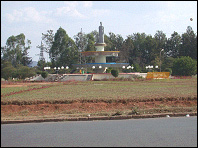
Kigali, despite concessions to modernity, retains
a satisfyingly organic shape and unpretentious low-rise
charm. The compact city center, which surrounds
a busy, colourful market, is studded with souvenir
stalls displaying fine local craftsmanship, while
leafy avenues wind through hilly suburbia, and the
atmospheric Muslim quarter. Safe, and overwhelmingly
friendly, Kigali enjoys a temperate high-altitude
climate which belies its tropical location and appearance,
and is centrally located within three hours of most
of Rwanda's tourist sites.
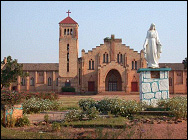
Rwanda's second city, Butare, situated 135km south
of the capital, is the intellectual and cultural
heart of the nation, set a short distance from the
traditional seat of the feudal monarch, and the
site of numerous academic institutions including
the country's largest university. The main road
through this compact and sedate small city is lined
with inexpensive but comfortable hotels and breezy
terrace restaurants. On the outskirts of Butare,
Rwanda's National Museum houses the finest ethnographic
collection in East Africa. The absorbing displays
of traditional artifacts, illuminated by turn-of-the-century
monochrome photographs, provide insights into not
only Rwanda's pre-colonial lifestyles, but also
its subsequent development into a modern African
state. Within easy day-tripping distance of Butare,
the Royal Palace of Nyanza is an enormous traditionally
constructed dome, no longer in active use, painstakingly
maintained as a museum.
|

